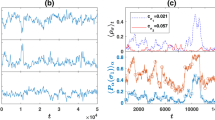Abstract
This paper describes our most recent investigations into aggressive communication. We perform experiments in a simple synthetic ecology, in which simulated animals (animats) are in competition over food. In the first experiment, each animat has an evolved signaling strategy — the degree to which that animat ‘bluffs’ about its aggression level. The form of artificial evolution used features no explicit fitness function. By varying the cost of signaling, we show that the general logic of the handicap principle (according to which high costs enforce reliability) can apply in the sort of ecological context not easily studied using formal models. However, because an animal's behavioural response to an incoming signal will be determined not only by the signal itself, but also by the degree of importance that that animal gives to the signal, we go on to introduce the concurrent evolution of signaling and receiving strategies. We discuss how, in this more complex scenario, the cost of signaling affects the reliability of the signaling system.
Preview
Unable to display preview. Download preview PDF.
Similar content being viewed by others
References
J. Archer. The Behavioural Biology of Aggression. Cambridge University Press, Cambridge, 1988.
P. de Bourcier and M. Wheeler. Signalling and territorial aggression: An investigation by means of synthetic behavioural ecology. In D. Cliff, P. Husbands, J.-A. Meyer, and S. W. Wilson, editors, From Animals to Animats 3: Proceedings of the Third International Conference on Simulation of Adaptive Behavior, pages 463–72, Cambridge, Massachusetts, 1994. M.I.T. Press / Bradford Books.
M. Enquist. Communication during aggressive interactions with particular reference to variation in choice of behaviour. Animal Behaviour, 33:1152–1161, 1985.
A. Grafen. Biological signals as handicaps. Journal of Theoretical Biology, 144:517–546, 1990.
A. Grafen and R.A. Johnstone. Why we need ESS signalling theory. Philosophical Transactions of the Royal Society: Biological Sciences, 340:245–250, 1993.
J. R. Krebs and N. B. Davies. An Introduction to Behavioural Ecology. Blackwell Scientific, Oxford, 2nd edition, 1987.
K. Lorenz. On Aggression. Methuen, London, 1966.
J. Maynard Smith. Evolution and the Theory of Games. Cambridge University Press, Cambridge, 1982.
P.K. McGregor. Signalling in territorial systems: a context for individual identification, ranging and eavesdropping. Philosophical Transactions of the Royal Society: Biological Sciences, 340:237–244, 1993.
M. Stamp Dawkins and T. Guilford. The corruption of honest signalling. Animal Behaviour, 41(5):865–73, 1991.
I.J.A. te Boekhorst and P. Hogeweg. Effects of tree size on travelband formation in orang-utans: Data analysis suggested by a model study. In R. Brooks and P. Maes, editors, Proceedings of Artificial Life IV, pages 119–129, Cambridge, Massachusetts, 1994. M.I.T. Press.
M. Wheeler and P. de Bourcier. How not to murder your neighbor: Using synthetic behavioral ecology to study aggressive signaling. Technical Report 357, School of Cognitive and Computing Sciences, University of Sussex, 1994. Submitted to the journal Adaptive Behavior.
A. Zahavi. Mate selection — a selection for a handicap. Journal of Theoretical Biology, 53:205–214, 1975.
Author information
Authors and Affiliations
Editor information
Rights and permissions
Copyright information
© 1995 Springer-Verlag Berlin Heidelberg
About this paper
Cite this paper
de Bourcier, P., Wheeler, M. (1995). Aggressive signaling meets adaptive receiving: Further experiments in synthetic behavioural ecology. In: Morán, F., Moreno, A., Merelo, J.J., Chacón, P. (eds) Advances in Artificial Life. ECAL 1995. Lecture Notes in Computer Science, vol 929. Springer, Berlin, Heidelberg. https://doi.org/10.1007/3-540-59496-5_341
Download citation
DOI: https://doi.org/10.1007/3-540-59496-5_341
Published:
Publisher Name: Springer, Berlin, Heidelberg
Print ISBN: 978-3-540-59496-3
Online ISBN: 978-3-540-49286-3
eBook Packages: Springer Book Archive




